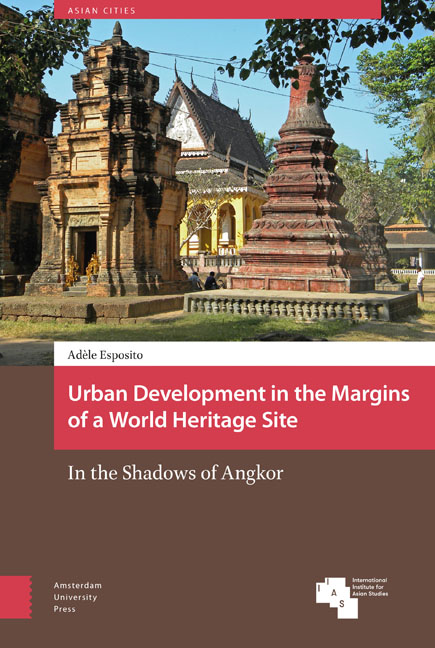Book contents
- Frontmatter
- Dedication
- Contents
- List of Figures
- Abbreviations
- Glossary of Khmer terms
- Acknowledgements
- Author’s Preface
- Introduction
- 1 ‘Before you Build a Wall, Think of What You are Leaving Outside it’: The Construction of Core and Marginal Spaces in the Angkor Region
- 2 The Arena of Urban Planning and the Idea of the City
- 3 The City as Developers’ Playground
- 4 The Architectural Space: How Contemporary Design Shapes Urban Identities and Ideas of Modernity
- Conclusion
- Bibliography
- Index
- Publications / Asian Cities
- Frontmatter
- Dedication
- Contents
- List of Figures
- Abbreviations
- Glossary of Khmer terms
- Acknowledgements
- Author’s Preface
- Introduction
- 1 ‘Before you Build a Wall, Think of What You are Leaving Outside it’: The Construction of Core and Marginal Spaces in the Angkor Region
- 2 The Arena of Urban Planning and the Idea of the City
- 3 The City as Developers’ Playground
- 4 The Architectural Space: How Contemporary Design Shapes Urban Identities and Ideas of Modernity
- Conclusion
- Bibliography
- Index
- Publications / Asian Cities
Summary
Since colonial times, Angkor has captured the attention of the international heritage community and has been seen as one of the most important archaeological sites in the world. It has also become a major international tourist destination, especially after being listed as a UNESCO World Heritage Site in 1992. Today, it is visited by more than two million tourists every year. Tourism plays a significant role in the reconstruction of the national economy. Cambodia has gone through twenty years of turmoil: the dictatorial regime of the Khmer Rouge, the civil war, and the Vietnamese occupation destroyed social organizations, economic growth, and the transmission of culture and traditions. When Cambodia eventually regained its status as an independent and sovereign country in 1991, its political, social, and economic systems had to be rebuilt from scratch with the assistance of the United Nations. Reconstruction efforts coincided with the recognition of Angkor as the heritage of humanity, only one year later. International fame bolstered hope for economic development, while at the same time it aroused concern for the reconstruction of the national identity based on Cambodia's archaeological heritage. Angkor has come under the spotlight of post-war development. It has monopolized the institutional concern for heritage, preventing other forms of legacy from being recognized as valuable. The focus of cultural policy in Angkor has gone hand in hand with the convergence of wealth and investment in Siem Reap. In 2007, this town, located six kilometres away from the main temples, was still surrounded by one of the poorest rural areas in the country.
The sharp contrasts between celebration and indifference, wealth and poverty, caught my attention when I first visited Cambodia as a postgraduate student in 2005. Developers and speculators have invested large amounts of capital in Siem Reap during the last twenty years. However, the town has lacked any kind of cultural policy or programmes for urban conservation and planning. While the focus of scholarship has mainly been directed to the magnificent remains of Angkor, I became interested in its urban surroundings, which embodied an intriguing contradiction between cultural marginality and economic centrality.
In my own early life in Turin, a secondary city in northwest Italy, my first experiences of the urban environment generated a sense of marginality.
- Type
- Chapter
- Information
- Urban Development in the Margins of a World Heritage SiteIn the Shadows of Angkor, pp. 19 - 22Publisher: Amsterdam University PressPrint publication year: 2018



